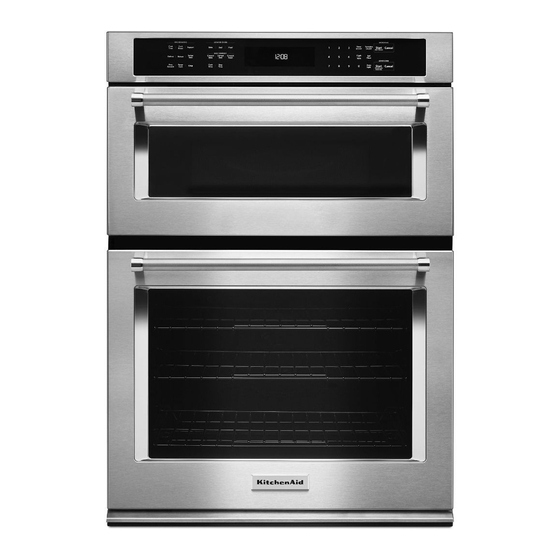KitchenAid KOCE500ESS01 Manuel de l'utilisateur - Page 11
Parcourez en ligne ou téléchargez le pdf Manuel de l'utilisateur pour {nom_de_la_catégorie} KitchenAid KOCE500ESS01. KitchenAid KOCE500ESS01 20 pages. Built-in electric ovens

To Replace SatinGlide™ Roll-out Extension Rack
1. Using 2 hands, grasp the front of the closed rack and the
sliding shelf. Place the closed rack and the sliding shelf on the
rack guide.
2. Using 2 hands, lift up on the front edge of the rack and the
sliding shelf together.
3. Slowly push the rack and the sliding shelf to the back of the
oven until the back edge of the rack pulls over the end of the
rack guide.
To avoid damage to the sliding shelves, do not place more than
25 lbs (11.4 kg) on the rack.
Do not clean the SatinGlide™ roll-out extension rack in a
dishwasher. It may remove the rack's lubricant and affect its ability
to slide.
See the "General Cleaning" section for more information.
Bakeware
The bakeware material affects cooking results. Follow
manufacturer's recommendations and use the bakeware size
recommended in the recipe. Use the following chart as a guide.
BAKEWARE/
RECOMMENDATIONS
RESULTS
Light colored
aluminum
Light golden crusts
Even browning
Dark aluminum and
other bakeware with
dark, dull and/or
nonstick finish
Brown, crisp crusts
Insulated cookie
sheets or baking
pans
Little or no bottom
browning
Stainless steel
Light, golden
crusts
Uneven browning
Stoneware/Baking
stone
Crisp crusts
Ovenproof
glassware, ceramic
glass or ceramic
Brown, crisp crusts
Meat Thermometer
Not all models have a temperature probe. On models without a
temperature probe, use a meat thermometer to determine whether
meat, poultry and fish are cooked to the desired degree of
doneness. The internal temperature, not appearance, should be
used to determine doneness.
Use temperature and time
recommended in recipe.
May need to reduce baking
temperatures slightly.
Use suggested baking time.
For pies, breads and casseroles,
use temperature recommended in
recipe.
Place rack in center of oven.
Follow rack recommendations in
the "Rack and Bakeware Positions"
section.
May need to increase baking time.
May need to increase baking time.
Follow manufacturer's instructions.
May need to reduce baking
temperatures slightly.
Oven Vent(s)
A
B
C
D
E
F
Combination Microwave Oven
A. Control panel
B. Microwave oven vent
C. Microwave oven
The oven vent(s) should not be blocked or covered since they allow
the inlet of fresh air into the cooling system. Also, the bottom vent
should not be blocked or covered since it allows the inlet of fresh
air into the cooling system and the outlet of hot air from the cooling
system. Blocking or covering vents will cause poor air circulation,
affecting cooking, cleaning and cooling results.
Preheating and Oven Temperature
Preheating
When beginning a Bake or Convect Bake cycle, the oven begins
preheating after Start is touched. The oven will take approximately
12 to 17 minutes to reach 350°F (177°C) with all of the oven racks
provided with your oven inside the oven cavity. Higher
temperatures will take longer to preheat. The preheat cycle rapidly
increases the oven temperature. The actual oven temperature will
go above your set temperature to offset the heat lost when your
oven door is opened to insert food. This ensures that when you
place your food in the oven, the oven will begin at the proper
temperature. Insert your food when the preheat tone sounds. Do
not open the door during preheat until the tone sounds.
Oven Temperature
While in use, the oven elements will cycle on and off as needed to
maintain a consistent temperature. They may run slightly hot or
cool at any point in time due to this cycling. Opening the oven door
while in use will release the hot air and cool the oven which could
impact the cooking time and performance. It is recommended to
use the oven light to monitor cooking progress.
11
D. Oven vent
E. Lower oven
F. Bottom vent
